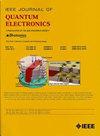Generation of Stretched and Soliton Pulses From Passively Mode-Locked EDFL Utilizing Nickel-Phosphorus Trisulfide (NiPS3)-Based Saturable Absorber
IF 2.1
3区 工程技术
Q3 ENGINEERING, ELECTRICAL & ELECTRONIC
引用次数: 0
Abstract
In this study, a nickel-phosphorus trisulfide (NiPS3) saturable absorber (SA) with a ~20.9% modulation depth was used for mode-locking in an erbium-doped fiber laser (EDFL) operating in near-zero and anomalous dispersion regimes. The SA was formed by depositing a layer of NiPS利用三硫化镍-磷(NiPS3)基饱和吸收剂从被动锁模EDFL产生拉伸和孤子脉冲
在这项研究中,三硫化镍磷(NiPS3)饱和吸收体(SA)具有~20.9%的调制深度,用于在近零和异常色散状态下工作的掺铒光纤激光器(EDFL)的锁模。在圆弧型纤维上沉积一层NiPS ${}_{\mathbf{3}}$材料形成SA。产生的脉冲最初是在拉伸脉冲状态下观察到的。然后,在腔中加入84 m长的单模光纤(SMF),使其在异常色散状态下工作。在拉伸色散和异常色散情况下,脉冲的中心波长分别为1566.6 nm和1561.6 nm,测量到的3-dB带宽分别为3.2 nm和1.4 nm。对应的重复频率分别为6.6 MHz和1.8 MHz,而高斯和sech ${}^{\mathbf{2}}$谱线的脉冲宽度分别为1.53 ps和2.25 ps。在延伸和孤子区,脉冲的信噪比分别为~66 dB和~49 dB,获得了稳定的锁模操作。本文的研究结果对c波段锁模光纤激光腔的优化设计具有一定的指导意义。
本文章由计算机程序翻译,如有差异,请以英文原文为准。
求助全文
约1分钟内获得全文
求助全文
来源期刊

IEEE Journal of Quantum Electronics
工程技术-工程:电子与电气
CiteScore
4.70
自引率
4.00%
发文量
99
审稿时长
3.0 months
期刊介绍:
The IEEE Journal of Quantum Electronics is dedicated to the publication of manuscripts reporting novel experimental or theoretical results in the broad field of the science and technology of quantum electronics. The Journal comprises original contributions, both regular papers and letters, describing significant advances in the understanding of quantum electronics phenomena or the demonstration of new devices, systems, or applications. Manuscripts reporting new developments in systems and applications must emphasize quantum electronics principles or devices. The scope of JQE encompasses the generation, propagation, detection, and application of coherent electromagnetic radiation having wavelengths below one millimeter (i.e., in the submillimeter, infrared, visible, ultraviolet, etc., regions). Whether the focus of a manuscript is a quantum-electronic device or phenomenon, the critical factor in the editorial review of a manuscript is the potential impact of the results presented on continuing research in the field or on advancing the technological base of quantum electronics.
 求助内容:
求助内容: 应助结果提醒方式:
应助结果提醒方式:


